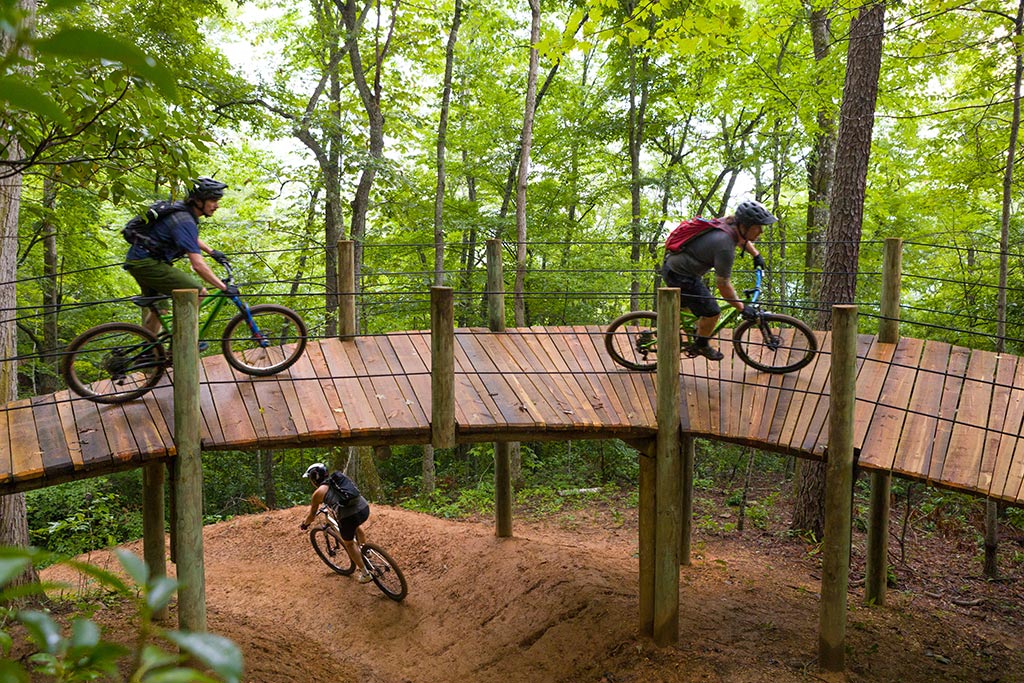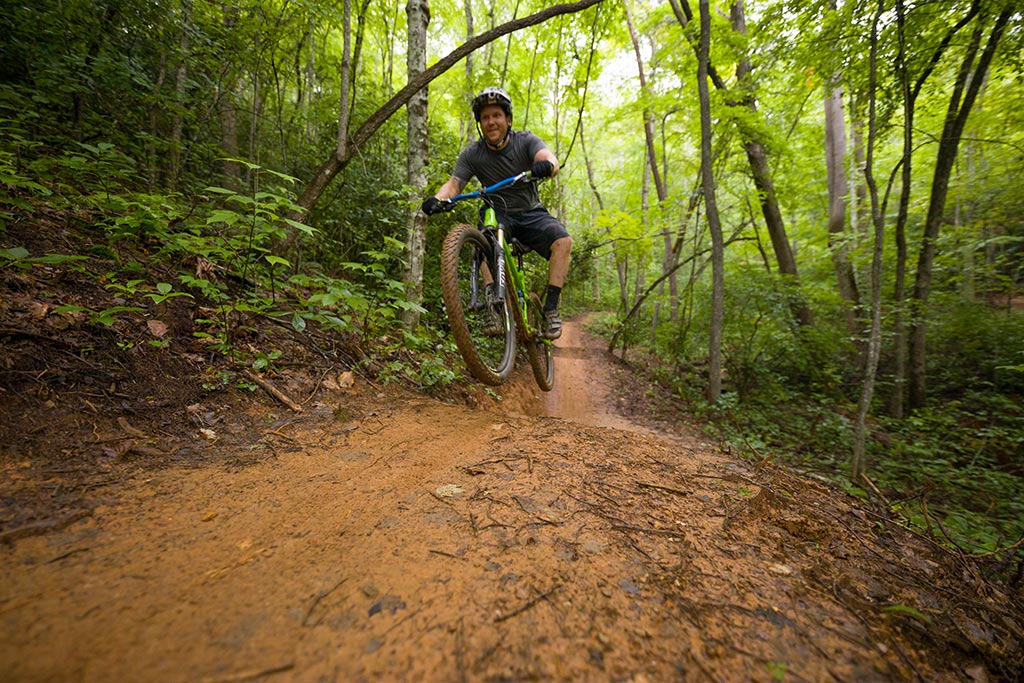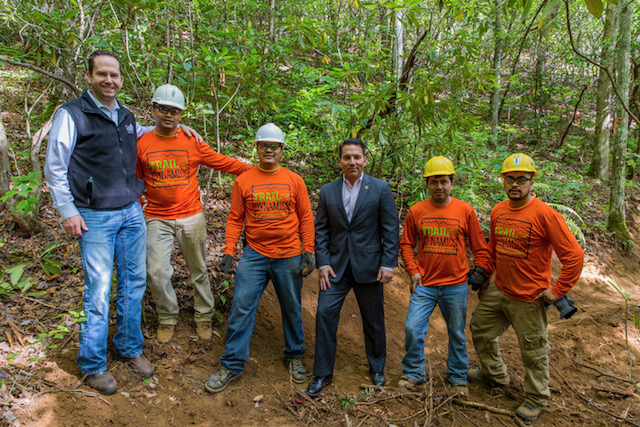I know I’m going to eat it somewhere in the middle of the berm. It’s a beautiful wave of dirt, piled high and smooth, but I’m carrying too much speed as I enter the top of it. I picture my bike going one direction and my body going the other and consider feathering my brakes and dropping my inside foot—just a little dab to keep the ride in my comfort zone as I transition from the head of the berm into the tail, but I hold fast. I let it ride, carrying more speed than normal and to my surprise, the dirt holds. My tires hold. My feet stay on the pedals and I come out of the berm almost as fast as I went into it. I automatically start pedaling toward a tabletop 20 yards ahead. And another after that. And another.
This is the most fun I’ll have today. Scratch that. This is the most fun I’ve had in weeks. Until I hit another berm that leads into a rhythm section of rollers.
The ride works like that, moving from one highlight to the next until I make my way down the entire side of Fire Mountain, a new trail system located on the Qualla Boundary, on Cherokee land in western North Carolina. It’s not a large trail system, just 10.5 miles, but there’s so much flow built into the dirt that in less than a year after being constructed, Fire Mountain has become one of North Carolina’s hottest ride destinations. It’s the focus of enthusiastic YouTube videos and MTB Project reviews. This is exactly what the Eastern Band of Cherokee Indians had in mind when they decided to build it.
“Fire Mountain has created the biggest buzz in Cherokee since the casino opened.”
The Qualla Boundary covers more than 56,000 acres in the mountainous southwestern corner of the state. It’s a gateway community to the nearby Great Smoky Mountains National Park and has a substantial tourism infrastructure that ranges from roadside shops to world-class cultural exhibits. But like more than 200 tribal nations across the country, the Cherokee rely on their 175,000-square-foot casino and hotel as the community’s primary economic driver.
“Harrah’s [Casino] changed everything,” says Jeremy Hyatt, the secretary of operations for the Eastern Band of Cherokee Indians, and one of the masterminds behind Fire Mountain. Hyatt grew up in Cherokee, North Carolina, and remembers when almost half the population was unemployed before the casino opened in the late 1990s. “It’s been a boon to the economy, creating opportunities and providing funds for infrastructure projects. But we have all our eggs in that one basket.”
The goal of Fire Mountain, which opened May 2017: create new economic growth through ecotourism and provide a healthier lifestyle for their own community.
“Fire Mountain has created the biggest buzz in Cherokee since the casino opened,” Hyatt says.

Photo Credit: EBCI Destination Marketing
This comes at a time when many tribal nations are looking to diversify revenue sources, according to the American Indian Alaska Native Tourism Association (AIANTA), a nonprofit that works with tribal nations to develop their tourism programs. “In the last decade, we’ve seen a huge increase in museums and hotels without casinos being built,” says Rachel Cromer, the media specialist for AIANTA. “International visitation to Indian Country has also increased by 180 percent in the last decade, and we think that’s directly related to the cultural tourism opportunities available at various tribal nations.” Some tribes are building resort-style hotels without casinos, others are enhancing the cultural experience that tourists can tap into during a visit, and a few are banking on fresh singletrack to attract new visitors. The Navajo Nation (with land in Utah, New Mexico and Arizona) has a program capitalizing on the existing trails within its 30,000 square miles of high desert landscape, but tribes that are laying fresh singletrack are harder to find.
The Qualla Boundary has terrain similar to what you’ll find inside Great Smoky Mountains National Park. Think steep mountains thick with lush, green hardwoods, and narrow coves punctuated by fast, cold rivers.
“Mountain biking is a no-brainer,” says Hyatt, who points to the economic growth in Bentonville, Arkansas, as the inspiration for Fire Mountain, which was built last year by Trail Dynamics, a trail-building company out of Brevard that’s responsible for some of the best trail work in the Southeast. “I know that if we can build a phenomenal trail system, we can have a grassroots economy that can grow and bring in visitors who want to experience the land that the Cherokee have explored for generations.”
The ride begins from the parking lot for the Oconaluftee Indian Village, a living museum where you can see reenactments of the Cherokee way of life circa the mid-1700s. When I pull into the parking lot for my first ride of Fire Mountain, I find a group of guys unloading bikes from the back of a four-door pickup truck. They’ve driven up from Atlanta and are going to spend the next few days riding Dupont State Forest and Pisgah National Forest, some of the South’s most storied trail systems, but they’re beginning the trip with Fire Mountain. “I hear it’s fast,” one guy tells me.
It’s telling that in less than a year, Fire Mountain has already crept into the region’s singletrack highlight reel, and after a few minutes on the trail, I understand why: Fire Mountain isn’t like anything else in this area. Pisgah National Forest is arguably one of the best mountain bike destinations in the country, but it’s known mostly for its brutally technical trails. The singletrack is choked with rocks and old-school water bars and fall-line climbs and tons of gravel grinds connecting more root gardens and off-camber rock gardens. Pisgah offers its own kind of joy; a “Type 2” fun that’s often described as gnarly. Fire Mountain, on the other hand, offers three top-to-bottom descents full of groomed flow. It’s a pedaly sort of downhill with no real fall-line sections, and nothing too terribly technical to get in the way of your speed. There are long straightaways with tons of grade reversals that you can hammer if you’re looking for a challenge, or sit back and coast if you want to make it last. The berms are high and surfy. It is unabashed “Type 1” fun, the kind that causes giggles, and cramps in your cheeks from smiling too much.

Photo Credit: EBCI Destination Marketing
But listen, the “flow trail” status of Fire Mountain is a bit misleading. I’ve ridden flow trails in other parts of the world where pedaling is basically optional. That’s not the case here. For each of the three massive descents, you have to tackle an equally massive climb, and that climbing starts as soon as your tires leave the pavement. But somehow, the trail builders were able to make the most of this mountain, creating long, winding downhill runs that are almost as long as the climb to the top. And each descent has its own sense of character, which is a hard thing for flow trail systems—often criticized for similarity among trails—to accomplish.
The intermediate Uktena is a skinny vein of singletrack dropping through a tight hardwood canopy. The berms are demanding and tight, leading to plenty of roots and rocks and the occasional rhododendron tunnel. The flow is strong, but you have to pay attention to your line. Spearfinger and Tinker’s Dream are wider with more manageable berms and more mellow grade reversals. The black-diamond Kessel Run (tip of the hat for that Star Wars reference) is where riders can find the biggest speed. The berms are massive and lead into long, pumpy rhythm sections. In between those berms and rollers you’ve got small- to medium-sized tabletops that you can either roll or launch.
“I think it’s one of the best trail systems in the South,” says Cherokee Principal Chief Richard Sneed, a cyclist himself. Chief Sneed and the tribal council are encouraged by the early success of Fire Mountain. The Cherokee don’t have user data on the trail system yet but point to the bikes often seen in the parking lot, online buzz and the fact that a new bike shop and outfitter is opening soon near the trailhead as signs of the system’s early success.

Jeremy Hyatt (left) and Chief Richard Sneed (center) along with a local work crew on a trail at Fire Mountain. (Photo Credit: Kristy M. Herron)
But Chief Sneed says to be truly successful, he’d like to see more Cherokee pedaling the trails. “People in the community say they want to get a bike and start riding, but that’s something we’re going to have to promote from within and develop a program that encourages mountain biking. You have to be in shape to make it up that climb. But once you reach the top of the mountain, the downhill is so much fun. It’s worth the effort.”
Chief Sneed and the tribal council are beginning to consider different initiatives to get more members of the community on bikes. In the meantime, they’re hoping to use the popularity of Fire Mountain as a springboard for other ecotourism initiatives.
A new trout hatchery is in the works (fishing is currently the second biggest industry in Cherokee, North Carolina), and the council is considering opening an existing ATV trail system to non-Cherokee visitors. The kayaking potential is also intriguing, as is the potential for canopy tours and an adventure park.
According to Hyatt, there are also immediate plans to build out the infrastructure for Fire Mountain, giving it platforms in key spots throughout the system to provide bikers places to hang out. The tribe is also trying to identify other plots of land where additional mountain bike trails can be built. Meanwhile, local businesses are starting to capitalize on Fire Mountain’s popularity. In addition to the new bike shop and outfitter, two Cherokee women have plans to open a brewery near the bike shop if a referendum passes that will allow alcohol sales within the Qualla Boundary (currently, you can only buy alcohol inside the casino).
“There are so many opportunities for ecotourism in the Qualla Boundary,” Chief Sneed says. “But an expansion of Fire Mountain is our top priority. I don’t know if anyone imagined that the system would be as amazing as it is.”
